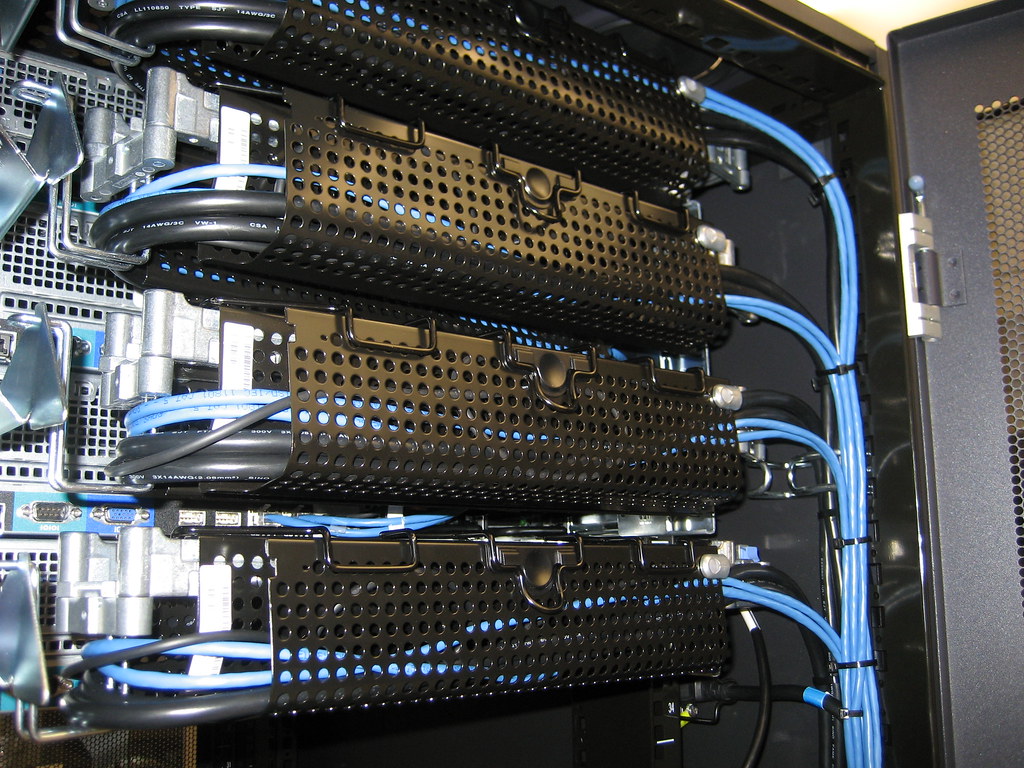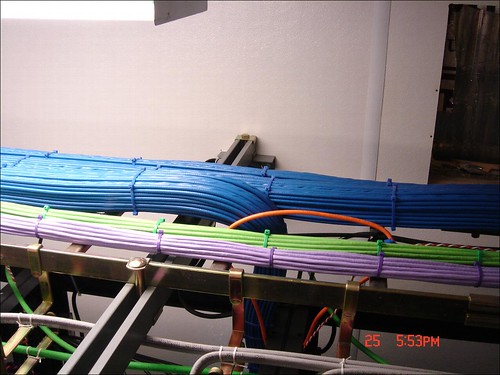Happy Friday to you, and welcome to the (semi, almost) weekly how-to. Today, by popular request, we're talking about cable management.
Good cable management defined is making cables, cords, and wires cleanly and neatly arranged, and it facilitates easy tracing of cables and simplifies replacing bad cables. A lot of time, these are all mutually exclusive, so we concentrate on the task at hand and taylor our cable management to that end. It also promotes good air flow in the back of the machines, which should be reason enough to do it.
Cable management is, to a lot of people, something you would rather be done with than do. It's also far easier to do when you don't have to take down the network or power from a running system. For this reason, it's important to keep it in mind in the beginning, when you're figuring out how you are going to cram all those wires wherever they need to go. The job isn't made easier by the huge number of places wires have to go, nor by the types of wires that you're dealing with. Lets break it down a little and see what the best policies are for each.
Shelved Computers

Whether this is a scene from your work, or your basement, almost all of us have been there. Industrial shelving with tower servers everywhere. Wild tangles of cable in the back, probably inaccessible against the wall, where they attract dust bunnies and cobwebs. It's not ideal, but it's all a lot of us have to deal with. What do you do to make it useful?
First, if your shelves are against the wall, pull it out at least a foot, if at all possible. The amount of heat being built up in the back is immense, and with nowhere to go, you're just baking the back of your equipment. Once you've got some space back there, you can go to work.
The major problem with industrial shelving is that it's not meant to hold servers, and there-for it has no cable management. It's easy to add your own. I have several runs of plastic cable runs that are open sided, with fingers to hold cable. Here's an example:

They can be several feet long, and work great on industrial shelves. Just mount them to the back of each shelf layer, and run your cables through there. Since they have the fingers, you just pull the cable out of the run and into the server where-ever you need. It works great, and looks neat and tidy.
It is important to remember that long runs of power cable should not be mixed with network cable. It would be best to run your ethernet cable along the top shelf, and power across the middle shelf. That would keep them separated, so as not to create massive packet loss.
If your cable duct is like those in the picture, with a "lid" to keep the cables contained, then great! Use it! They snap on and off easily, and really improve the look and airflow. They do make cheap ones without that cover though. I know because I have several. In that case, you're going to want to secure the cables together, so they don't fall out of the channel. For this task, lots of admins use plastic zip ties. That was my preferred tool, as well, until I discovered that velcro ties. They're just as easy, reusable, and you don't have to carry wire cutters to snip that last 6 inches of extra plastic. These qualities pale in comparison to the fact that, when you need to replace a cable at 3 in the morning, you don't need to find the wirecutters that you carry with you during the day. It's just "rriiiipp" and you have access to your cables. I cannot recommend these highly enough for any cable runs that you foresee replacing.
Typical Server Rack
The other major form factor for servers is rackmount. If you've never used it before, you might want to check the introduction I wrote a while back.
Since racks ARE meant to hold servers, all but the least expensive have built-in cable management. Typically there are channels running vertically up and down the back corners with access points placed intermittently along the way. Ideally, all your servers would have power cords on one side and network cables on the other. This is pretty much never the case. Still, I have all of my ethernet on the right side (if you're standing looking at the rack from behind it), and all my power on the left.

One note, when it comes to installing servers in the rack. Lots of servers (Dell, I know for sure. HP maybe) come with cable arms for the back of the rack. They flex and pivot, and are meant to allow you to pull the server out the front of the rack without having to unplug any of the cables. If your rack is low density, they're only mostly irritating, but if you've got several machines close together, the cable arms are a menace. They block airflow, hold heat, and I can count the number of times I've wanted to pull a server out while it was still on at 0. They're completely worthless to me, so I don't install them. I'll leave the decision to you, but my advice is that they make excellent ballast for empty garbage cans.
Cable length makes up a big part of keeping a rack clean, too. Assuming you have a typical 42u rack, the farthest apart two network ports can be is just over 6ft. Assuming you want to square off the corners and run the cable in straight lines, it's just over 9ft. Thus, you should never have a cable on your rack longer than 10ft. If you place your switches intelligently (in this case, facing the back of the rack, and in the middle, at around 21u from the bottom), you can cut that in half, for network cables. The majority of bad cabling jobs are due to improper lengths being used. If you're making your own cables, this is easy to remedy. If you're ordering them, you'll have to plan ahead. For my blade systems, I planned the rack layout ahead of time, and ordered the exact ethernet and fiber lengths I needed. Now there's no extra cables to block air, and there's no pile of cables at the bottom of the rack that I have to worry about.
You can crimp your own ethernet, but making power cables is a little more difficult. I'd instead recommend ordering exact lengths. You can get anywhere from 1ft to really long. Chances are very good that the right length exists for you already. If you don't have the time to wait on the cables, the next best thing is to only unwind as much cable as you need from the twist-tied cable bundle they sent with the computer. When you get the right length out, twist-tie the bundle back together. It's still neat, and stays out of the way.
Vertical / Horizontal Cable Runs

For our purposes today, the differences don't matter much. The important part is that we're running semi-permanent cables between places. Because of this difference, where I recommended velcro before, I recommend zip ties now. Due to the number of cables that are frequently run in this way, the bundle is often too big for velcro anyway, and since the install is permanent, you won't have to worry about taking the cables down often (at least, you hope not).
Let us not overlook the most common type of computer in offices, the humble desktop. Pound for pound, it can create a larger mess of cables than that 6u beast in the rack. Couple this with the tendency to put desktops on the floor, right next to feet, and you've got a mess in the making.
The best tools for these I've found are the plastic tubes with slits cut in them. There are some more extreme measures, but the plastic tubes usually work pretty well. The only issue is that my peripherals come with an irritatingly short cord. Most of the time, it seems like part of the cable is being wasted going to the ground, then going all the way back up to my desk. You can remove that slack with sticky cable tie squares.
Review
As you can see, there's no end-all be-all solution to cable management. It's an ongoing struggle, and the number of solutions that people have provided is mind-boggling. That just goes to show that it's a difficult problem to solve.As an admin, there's really no book or course that you can take (that I've heard of, anyway) to improve your skills. It's very much an apprentice type knowledge, and your cable management skills are likely a reflection of who you learned from, and what you've managed to find on the internet. I know I've come by my knowledge through trying things, testing them, and using critical thinking, and I'm sure you have too. For this reason, in order to increase the general knowledge on the subject, please comment below with your own tips, techniques, and criticism of my take on it. I'm the first to admit that I'm not the best at cable management, but I've been doing it long enough that they're a lot better than they used to be. Hopefully they'll help someone earlier on the curve get better faster, and that will help us all improve.
(photos courtesy of Jonathan Auer, cableorganizer.com, madferrett, Jason Froemming, and Rob Dudley)






